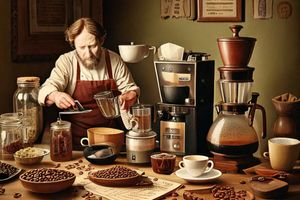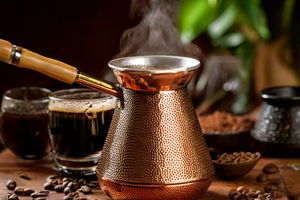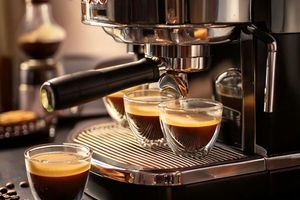Choosing Your Coffee
- For filter coffee, it's best to opt for freshly roasted, medium or light roast (filter roast) high-quality coffee — Specialty Coffee, as these varieties best reveal their aromatic and flavor properties with this brewing method.
- The coffee should be ground to a medium coarseness (suitable for filter or French press). The grind should not be too fine to avoid excessive bitterness.
Coffee and Water Proportions
- The typical ratio is 6 grams of coffee per 100 grams of water. However, this can vary according to personal taste.
- For tasting, you might use 18 grams of coffee for 250-300 grams of water.
Water Temperature
The optimal water temperature for brewing filter coffee is 92-96°C. The water should be hot but not boiling, to preserve the flavor qualities of the coffee.
Brewing Method
- Depending on the equipment (pour-over, drip coffee maker, filter system), use the appropriate method as instructed.
- For a pour-over (manual method), usually start by pouring a small amount of water (about 30 ml) to "bloom" the coffee, then gradually add the rest of the water in a circular motion.
Brewing
- In the case of a drip coffee maker, simply pour water into the reservoir and turn on the device.
- For pour-over or manual brewing: water should drip slowly through the coffee, without hindering extraction.
Tasting Filter Coffee
Aroma
The coffee can have a very pleasant aroma, especially after it has cooled down a bit. Evaluate which notes are detectable in the aroma: floral, spicy, caramel, chocolate, fruity, etc.
First Sip
- After the coffee has slightly cooled, take your first sip.
- Assess the acidity and sweetness of the coffee. The acidity in filter coffee can be very mild, with hints of citrus or fruity aromas.
- The sweetness in this brewing method is usually not very pronounced but may be present in the form of caramel or honey shades.
Bitterness and Body
- The second sip will allow you to assess the bitterness in the aftertaste and the body (richness) of the drink. Filter coffee usually has less bitterness than espresso or coffee made in a Turkish pot.
- The body of filter coffee can be light or medium, depending on the coffee variety and brewing method.
Drink's Bouquet
Use the flavor and aroma wheel to find descriptors (taste qualities) in the coffee you are drinking. Move from the center to the edge of the wheel.
Technical Settings
- If the coffee seems too acidic or watery, adjust the amount of coffee or water, or brew the drink at a slightly higher temperature.
- If the coffee is too bitter or harsh, try reducing the amount of coffee, the temperature, or the extraction time.
Tasting Notes Example
"Colombian Coffee"
- Acidity: 3
- Sweetness: 4
- Bitterness: 2
- Body: 3
Bouquet: citrus, flowers, berries
Liked: light fruity aroma with notes of red berries, good balance between acidity and sweetness.
Disliked: perhaps the aftertaste was a bit too sour, next time I will reduce the brewing time by 10-15 seconds.
Feedback
After each tasting, it's important to assess your coffee and make adjustments based on your taste preferences: change the proportions, water temperature, or brewing time to achieve the best result. And don't forget to give us feedback after each tasting, so we can tailor the origin country and coffee lot to your preferences.


















